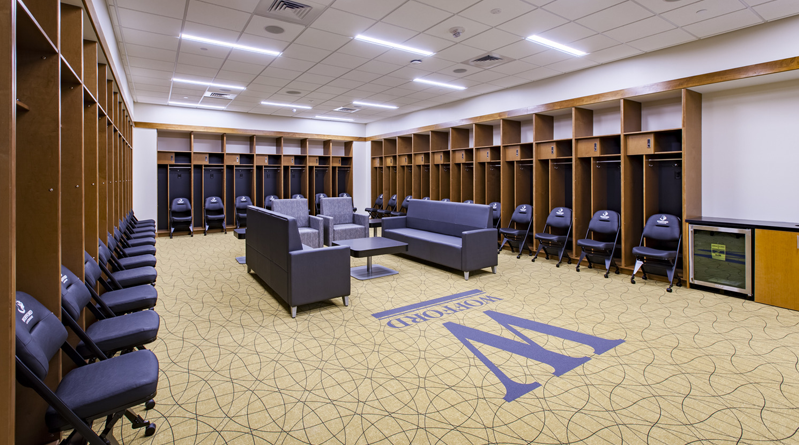Designing College Locker Rooms to Bring Top Football Talent
By Kurt Ludwick
College sports are key for schools to raise funds and build camaraderie and school pride among students and alumni. Aside from an experienced coaching staff, catchy fight song and unique mascot, a successful college team needs good players. While Division I schools may have the recruiting advantages of name recognition, deep fan bases and high-end athletic facilities, Division II and Division I FCS universities can attract top-level talent by creating well-designed locker rooms that provide a premier experience for athletes.
Larger Division I schools might spend $10,000 or more per locker, but Division II and Division I FCS schools can create a similar environment that attracts the best talent for closer to $1,000 per locker. Just because these locker rooms cost roughly 10% of what Division I schools spend doesn’t mean they resemble dank, claustrophobic caves.
In fact, well-designed DII and FCS locker rooms are packed with amenities that turn them into much more than just a place to change before and after practice.
Make it personal
Smaller schools can inspire excitement and pride in recruits by incorporating strong branding into locker room facilities. Mannequins placed in prominent locations displaying home and away uniforms can impress prospective athletes as they imagine themselves donning the team’s colors running out on the field or taking the court.
Features like LED lighting in school colors, school logos on furniture and custom carpeting can evoke a sense of school pride. Wofford’s Jerry Richardson Stadium features the “W” logo on carpets and the Terrier mascot on seat backs in player locker rooms and training areas. With the rise of social media, locker rooms are no longer behind the scenes. Branding is an important consideration when designing these spaces, since videos and cell phone pictures taken by student athletes and equipment managers in locker rooms often appear on their social media feeds.
A team with a well-branded locker room might even designate an area to record post-game celebrations, player award announcements, guest of honor visits or a coach’s game day speech.
Personalization is another feature that can help players feel like a valued, important part of the team. Lockers should have placards that display a player’s number and nickname for them to take home after graduation.
Lounge areas
The modern collegiate locker room also serves as a players’ lounge, study hall and meeting room. Creating a comfortable and attractive environment for players to spend time in helps strengthen the sense of camaraderie among teammates and coaches.
The locker room at Furman University features a gaming lounge with PlayStation systems adjacent to the locker room. In addition to a gaming area, Mercer University has a glass-walled area for athletes to use as a study hall.
Locker room lounges and study halls are common features that can make a big impression on recruits. They should include a variety of soft, comfortable seating, and have strong Wi-Fi signals. Strategically placed monitors throughout locker rooms and lounges can be used for film study, to watch live sports or to display schedules for athletes.
Lockers and benches
The optimal locker room layout keeps an open floor plan within the center of the room to maximize sightlines for coaches, training staff and teammates. Lockers should be placed close enough to intelligently utilize floor space while still providing ample elbow room for players to change. Built in benches are preferable to folding chairs because they are efficient and keep the locker room from looking cluttered.
Lockers can range in size from 24 by 24 inches for most sports to up to 33 by 33 inches for football or lacrosse. Each locker should have a space for the athlete’s helmet, jersey and equipment to maintain an organized, consistent look across the locker room.
To charge up phones and laptops during practice, USB access within each locker is ideal. However, standard power plugs can be installed at a lower cost.
Finishes and sanitation
Maintaining a clean environment is an important part of locker room design and will continue to be a top priority in the post-COVID-19 era. Devices like bipolar ionizers and UV-C lights can be installed within HVAC systems and ductwork, but implementing high-quality air filtration is the most cost-effective way to ensure a clean supply of fresh air. High ceilings and frequent air exchanges contribute to clean air while minimizing odors.
Milliken , Tarkett or Shaw offer attractive carpeting options that are quieter and more comfortable than rubber flooring and easy to sanitize. Kinetex flooring is also popular in several education and healthcare settings because of its soft surface and better ability than rubber or hard surface flooring to trap airborne air particulates that trigger allergies and cause infection.
A clever solution for handwashing and temperature checks was installed in the locker room facility at Furman. The hand washing station at the locker room entrance has a temperature gauge installed in the wall above the sink, so athletes can check their temperature while washing their hands before entry, making the process seamless, quick and easy.
Competing for talent with big-name universities can be a challenge for Division II and Division I FCS schools with smaller budgets, but following these tips for a well-designed locker room can attract star athletes with a desirable and effective atmosphere without breaking the bank.
Kurt Ludwick, AIA, NCARB is a Principal and Director of the Sports and Recreation Studio of McMillan Pazdan Smith, a regional, studio-based design firm with offices in Spartanburg, Charleston, Columbia and Greenville, South Carolina; Asheville and Charlotte, North Carolina; and Atlanta, Georgia.

